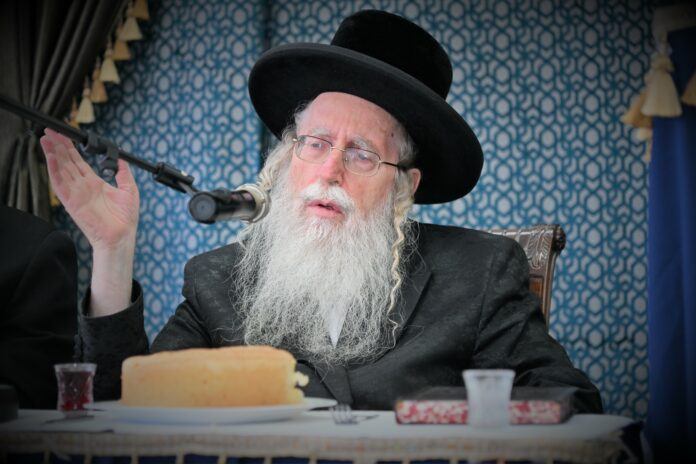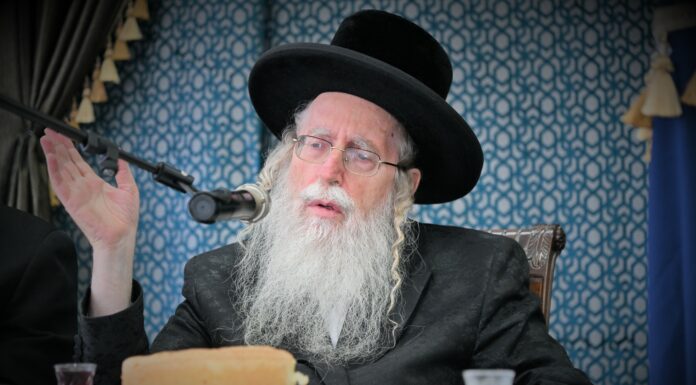One of the most revered rebbes of the prior generation was the Sanz-Klausenberger Rebbe, Rav Yekusiel Yehudah Halberstam, zt”l. In addition to his exceptional geonus and tzidkus, he was wholeheartedly involved in uplifting the survivors and rebuilding world Jewry after the devastation of the Holocaust. What he accomplished in a period of only 40 years from the war’s end until his passing in Tamuz of 1994 is beyond our ability to describe. However, his sefarim and the communities that he built throughout the world remain as testaments to his everlasting impact on klal Yisrael.
Almost 30 years after his petirah, I have the great privilege to visit Rav Berel Weiss in Kiryas Sanz, Yerushyalayim.
Rav Berel Weiss is a world-renowned talmid chacham in his own right about whom Rav Elyashiv wrote in his haskamah for the opening of the machon that prints Rav Weiss’ sefarim, “sar haTorah, unique in his generation and master of the Talmud.” It was because of his tremendous Torah knowledge that the Klausenberger Rebbe took him as a son-in-law. As Rav Weiss exits the shul, he beckons for me to join him on his walk home. He presents a noble and dignified figure with his long white beard and curly peiyos, and he speaks in a gracious, gentle tone of voice.
Family connection
“My kesher with the shver goes back many years before I became the Rebbe’s son-in-law,” he begins. “My father, Reb Moshe, was in Auschwitz during the Holocaust. When he heard that the Rebbe was in a different part of the camp, he traded places with another prisoner. This was possible because the Nazis didn’t have pictures of the inmates, only a chart with their names and the number of people in each section. It was there that he became close to the Rebbe.”
Their connection only grew stronger after the camps were liberated, when the Rebbe sought volunteers to help him bury the dead and give them a proper kever Yisrael. “My father was the only one who volunteered. The two of them somehow got hold of an army jeep and roamed the surrounding areas searching for bodies from sunrise to sunset. Because of his efforts, the Rebbe bentched my father and told him that he would have children who teach Torah and light up the world. Baruch Hashem, my brothers and I are all involved in harbatzas haTorah.”
In addition to Rav Berel, Reb Moshe was zocheh to have several other illustrious sons, including the distinguished posek Rav Asher Weiss, author of Minchas Asher, and Rav Chaim Weiss, the rav of Beitar Illit.
“After the war, the Rebbe devoted himself to establishing yeshivos and girls’ schools in Föhrenwald, a DP camp that was located near Munich, and my father became his right-hand man. My mother was a talmidah in the girls’ school, and the Rebbe was meshadech her with my father and served as their mesader kiddushin.”
But this was only the beginning of the connection between the Rebbe and Reb Moshe Weiss.
Immersed in Torah
Rav Berel Weiss was born in 1951 and learned in the Sanzer mosdos in Brooklyn. “The Rebbe would sit down with us in the evening to learn, and towards morning he’d be surprised when rays of sunlight began to filter into the room. ‘How can it be morning already?’ he would ask. It was only after he flipped the pages of the Gemara to see where we had started learning the night before that he realized how much time had elapsed. ‘Es ken zayn—it’s possible,’ he would concede.”
The Rebbe moved from America to Eretz Yisrael in 1960; Reb Moshe Weiss and his family followed a few years later. “I was almost 15 when we moved to Netanya, and I wanted to join the Rebbe’s yeshivah. Anyone who wanted to be in the Rebbe’s shiur had to be farhered by him on 300 blatt Gemara. It didn’t matter how old a bachur was; the Rebbe just wanted to make sure that each talmid possessed a certain level of bekius and kishronos.”
Rav Weiss is too humble to tell me that he aced his farher and was able to join the Rebbe’s shiur at the age of 14.
“A few months later, the Rebbe wanted the bachurim to be farhered on over 1,000 blatt Gemara, including Rashi and Tosafos. They were so immersed in learning even when they were outside the beis midrash that they would literally walk into things without noticing. The Rebbe fostered an environment of kol kulo Torah. He demanded excellence and led by example. I remember that in his later years he would sometimes suffer from debilitating headaches, but he was careful to never miss giving a shiur. He would have to be helped into the room, but as soon as he started learning, he’d get a sudden burst of energy and give the shiur with his usual gusto. The second the shiur was finished, he would feel the pain again and slump in his chair. It was amazing how his love for Torah allowed him to fully detach from the pain.”
Rav Weiss tells me that even though the Rebbe was totally dedicated to the klal and involved himself in communal matters, his true calling was learning and teaching Torah.
“Twice a week he would deliver a blatt shiur in which he taught the sugyos and illuminated their depths. There was no time limit and no clock. He would keep on going until he was satisfied that the talmidim understood things clearly. Most of the shiurim lasted around an hour and a half. And once a week he would give a shiur on Shulchan Aruch Choshen Mishpat.” Rav Weiss smiles as he recalls the memory of his formative years. “He loved to discuss difficult Teomims and Nesivos, and he would give entire pilpulim on a single passage. These shiurim were delivered with tremendous ahavas haTorah and a youthful spirit. He had a gleam in his eye and was animated the entire time. The shver also gave a weekly shiur on Shulchan Aruch Yoreh Dei’ah, a weekly shiur klali, and a Chumash with Rashi shiur. On Shabbos Mevarchim he’d also give a shiur to balebatim.”
For some people, however, the ultimate experience was the Rebbe’s shtikel Torah that he said by the tish on Friday nights.
To read more, subscribe to Ami





















